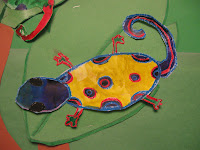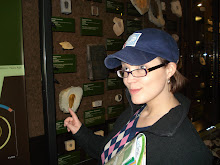 This project seemed like a good idea. And it was...it just took forever to finish, by the end we were all sick of it :-) but they came out really well. Fifth grade designed a small abstract design and repeated it 12 times. They colored the design and glued all 12 pieces to another piece of paper, rotating the image each time they glued it down. This created some really neat one of a kind abstract art.
This project seemed like a good idea. And it was...it just took forever to finish, by the end we were all sick of it :-) but they came out really well. Fifth grade designed a small abstract design and repeated it 12 times. They colored the design and glued all 12 pieces to another piece of paper, rotating the image each time they glued it down. This created some really neat one of a kind abstract art.
Every child is an artist. The problem is how to remain an artist once we grow up. ~Pablo Picasso
Tuesday, July 21, 2009
 This project seemed like a good idea. And it was...it just took forever to finish, by the end we were all sick of it :-) but they came out really well. Fifth grade designed a small abstract design and repeated it 12 times. They colored the design and glued all 12 pieces to another piece of paper, rotating the image each time they glued it down. This created some really neat one of a kind abstract art.
This project seemed like a good idea. And it was...it just took forever to finish, by the end we were all sick of it :-) but they came out really well. Fifth grade designed a small abstract design and repeated it 12 times. They colored the design and glued all 12 pieces to another piece of paper, rotating the image each time they glued it down. This created some really neat one of a kind abstract art. My first graders used the ripped edge of a manila folder and chalk pastels to make the sunset background. They made a thick line of color on the edge of the folder and brushed the color onto the background paper with their fingers. Messy and fun, they loved it! The mountains were made by ripping black construction paper and gluing it down on top of the sunset. Simple and the results were so rewarding.
My first graders used the ripped edge of a manila folder and chalk pastels to make the sunset background. They made a thick line of color on the edge of the folder and brushed the color onto the background paper with their fingers. Messy and fun, they loved it! The mountains were made by ripping black construction paper and gluing it down on top of the sunset. Simple and the results were so rewarding.



These beautiful oil pastel drawings were made by my fourth graders. We studied the "Pop Art" movement, and artists Andy Warhol and Wayne Thiebaud. The students were asked to choose their favorite food, and repeat the image several times. Color choices were completely up to them, the crazier the better. They came out GREAT!

 After a conversation with our school's PE teacher about how to spruce up the gym, I decided my fourth graders were up to the challenge.
After a conversation with our school's PE teacher about how to spruce up the gym, I decided my fourth graders were up to the challenge. I began with a lesson on mosaics, the history of them and how to make them,
They started with a simple drawing and then proceeded to cut small pieces of construction paper and glue them down to create these great results! The finished products will be on semi-permanent display in the gym.



 My first graders really enjoyed this "under the ocean" project. We began the project by looking at real photos taken under water, and exploring all the different types of creatures and plant found under the ocean. They used these images as inspiration or their drawings. The drawings were outlined in permanent black marker, then the creatures were colored in using watercolor pencils. The water was painted with regular water colors with salt sprinkled on top. The salt absorbed the paint and created the great water-like texture.
My first graders really enjoyed this "under the ocean" project. We began the project by looking at real photos taken under water, and exploring all the different types of creatures and plant found under the ocean. They used these images as inspiration or their drawings. The drawings were outlined in permanent black marker, then the creatures were colored in using watercolor pencils. The water was painted with regular water colors with salt sprinkled on top. The salt absorbed the paint and created the great water-like texture.Wednesday, April 29, 2009




 Over the February break, I was luck enough to take a little trip to Washington D.C. I adored seeing the pandas at the National Zoo and they inspired this lesson.
Over the February break, I was luck enough to take a little trip to Washington D.C. I adored seeing the pandas at the National Zoo and they inspired this lesson.Last year, after teaching how to use shading to make a more realistic picture ,I had my 5th graders work on a still life. This yeat they got to try their hand at shading a panda. I think they did a wonderful job! They used tempra paint for the panda, and chalk pastels for the bamboo background.
Friday, April 17, 2009





These great geckos were done by my 5th graders. I got the idea from the Usborne Art Ideas book (http://www.amazon.com/Usborne-Complete-Book-Art-Ideas/dp/0794514391/ref=sr_1_1?ie=UTF8&s=books&qid=1240025227&sr=1-1), a must have book for all art teachers!
The geckos were drawn in pencil, outlined in oil pastel, and painted in watercolor. Large construction paper leaves were cut out and used as the background. No matter how many projects they have done over the years with oil pastel resist, it never ceases to amaze the students. They love it every time.




This project coordinated with the 1st graders reviewing their "at" words ( The cat sat on the mat). I lead the class in a "how to draw" lesson on how to draw the cat. They then drew their own cat in pencil and used waterproof black marker to trace over the pencil and add their own details to the cat. They used watercolors to paint the cat. The mat was also drawn first in pencil, traced in marker, and painted in watercolor. When the cat and the mat were dry they were cut out and mounted on a colorful sheet of construction paper. I am so impressed with the results. Watercolors can be tricky and these 1st graders handled them wonderfully.
Saturday, April 11, 2009


 These are some examples of the adorable clay turtles that my 4th graders recently finished. The students started by making a pinch pot, and then they "pulled" clay out of the sides to create the head, legs, and tail. We used a variety of tools to add designs to the shell and details to the faces.The turtles are made from air dry clay since we have no kiln at our school ( a situation I am trying to remedy :-).After they were dry the students used solid tempera paint blocks to paint their turtles, and modge podge was used to seal the surface and give it a shiny, finished look. I think they came out fantastic!
These are some examples of the adorable clay turtles that my 4th graders recently finished. The students started by making a pinch pot, and then they "pulled" clay out of the sides to create the head, legs, and tail. We used a variety of tools to add designs to the shell and details to the faces.The turtles are made from air dry clay since we have no kiln at our school ( a situation I am trying to remedy :-).After they were dry the students used solid tempera paint blocks to paint their turtles, and modge podge was used to seal the surface and give it a shiny, finished look. I think they came out fantastic!

This is a project I originally saw on Artsonia, but I was so pleased with the job the students did I had to post them here. I used the lesson to discuss with my second graders the "power of observation". We spent time "observing" together the way snow sits on a branch and the way a complicated thing like a cardinal can be broken down into basic shapes ( ovals, circles, and triangles). The finished results drew ohhs and ahhs the whole time they were on display.
Subscribe to:
Posts (Atom)





















